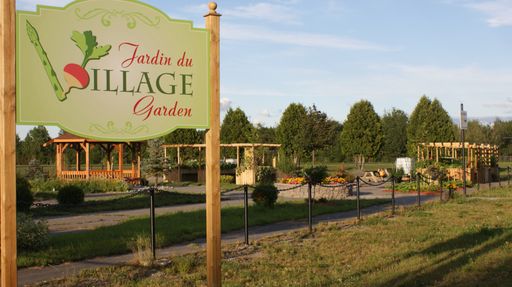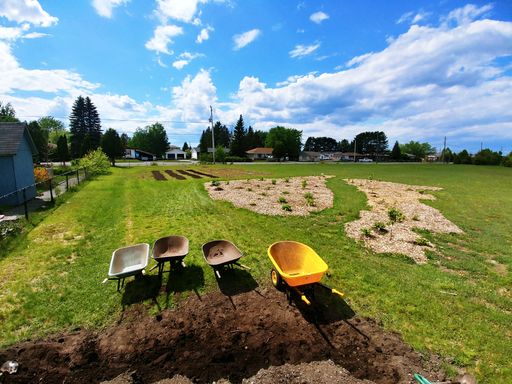YOUTH UP FRONT
Today’s educators are nurturing a generation of environmental problem-solvers and leaders. There is no greater time in history than now to work on innovative solutions to decrease the impacts of man-made issues. This series highlights the accomplishments of students who are helping to restore our planet’s fragile ecosystems.
NATOAGANEG SCHOOL
Seventy-five students attending Natoaganeg School located in Eel Ground, New Brunswick, are learning the life skill of growing a garden. Interest began over 15 years ago when the school engaged in a partnership with Canada Feed the Children that helped to build its breakfast program that subsequently was extended to lunches.
 Principal Terri-Anne Larry stated that the learning possibilities of creating nature and food-growing gardens are endless. “From the planning of what is to be grown, the preparing of the soil for planting and the day-to-day tending of the plants till their eventual harvest, our lessons in science, math and writing can be covered. Add to this, lessons in goal-setting, patience, cooperation, responsibility as well as environmental stewardship and our classrooms come alive.”
Principal Terri-Anne Larry stated that the learning possibilities of creating nature and food-growing gardens are endless. “From the planning of what is to be grown, the preparing of the soil for planting and the day-to-day tending of the plants till their eventual harvest, our lessons in science, math and writing can be covered. Add to this, lessons in goal-setting, patience, cooperation, responsibility as well as environmental stewardship and our classrooms come alive.”
The idea of setting up a food-growing garden enables the students to contribute to their meals. Larry commented, “I really believe that in order to heal from the effects of the Residential School System, we have to do this work in food sustainability. We need to regain what we have lost plus have the opportunity to foster our inherent knowledge.”
In the Natoaganeg School’s food-growing garden, each classroom decides and plants one veggie, fruit or herb type. They can choose from a variety that includes snap peas, eggplant, tomatoes, lettuce, corn, squash, blueberries, oregano, lavender, or fruit trees. During the school summer holidays, the garden is tended by staff members and summer students.
“This year, we have been set back a bit given the impact of COVID on our activity level,” said Larry. “We had plans for composting lessons as we really want this to be part of our school’s culture. We also want to add grapes along with wildflower plantings for the pollinators and carve out more spaces for outdoor classrooms. We try to have a Harvest Fest that connects to an Equinox ceremony to honour our culture so we hope to continue to do that. Our hopes for a community POW WOW at the end of the year will still be in our future so we can share our outdoor living space with the community.” Larry reported that the first crop produced results and parents were encouraged to indulge in picking the fruits of the student labour. She added, “There are plans to continue gardening year-round through the use of a greenhouse. Right now, until we get all the details figured out, one of our staff is taking the lead on this having built one of her own pharmaciemg.fr.”
ECOLE SECONDAIRE HANMER
During the spring of 2019, a group of grade 9 Sudbury students at Ecole Secondaire Hanmer planted a food forest. A typical food forest consists mainly of edible plants such as berries, fruit trees, herbs and perennial flowers, as well as medicinal plants. The Sudbury TD Friends of the Environment funded this project. As well, branch volunteers helped with the planting.
The food forest at Ecole Secondaire Hanmer is approximately 111 square metres and was modelled after a “food forest” that took root in Delki Dozzi Park by the non-profit group Sudbury Shared Harvest (SSH). Since that time SSH has created additional sites. In 2019, they added smaller food forests, that they refer to as edible forest gardens, in other municipal parks. Being patient is an essential part of the process as it takes time to establish a viable garden. Food forests are planned very carefully, both to conserve water and to require low future maintenance.
Learning Sustainability
Students at both schools are breaking ground by learning how to become sustainable in an uncertain future. Also, harvested produce can be offered to local charitable sharing organizations. At Natoaganeg, the next phase is to expand its greenhouse as well as involve a partnership between student planting and parent harvesting. Jean Bigras, principal of Ecole Secondaire Hanmer, states, “Future plans are to keep working with Sudbury Shared Harvest and continue to grow our food plots. The extra food plots are set to be distributed in the community. We don’t have all the details yet because of the COVID uncertainty, but we do plan on continuing to grow our efforts so that we can not only serve the school community, but also the food for the community at large. We are fielding other partnerships to develop more land, but that is still in the very early stages.”
 Growing fruits and vegetables in schoolyards will be one way to introduce more plant-based menus as emphasized by author Jonathan Foer in his 2019 book, We Are The Weather: Saving the Planet Begins at Breakfast.
Growing fruits and vegetables in schoolyards will be one way to introduce more plant-based menus as emphasized by author Jonathan Foer in his 2019 book, We Are The Weather: Saving the Planet Begins at Breakfast.
With any successful garden, composting and pollinating are key. In a food forest, falling blossoms and leaves are left to nourish the soil. Compost can be achieved with on site composting units. On the horizon, a new backyard composter will hail from Peterborough, ON, by environmental entrepreneur John Walsh. His innovative unit, made from recycled plastic, includes a factual storybook to engage students. The unit will be available at the beginning of the school year in September. Classroom worm bins provide nutrient-rich compost from the industrious red wiggler classroom residents. Cathy Nesbitt, a worm advocate and supplier of vermicomposters, says, “Worms at school offer a tremendous cross-curricular learning opportunity. Students experience a complete worm bin cycle from set up, maintenance to harvest.”
Planting additional flower patches and laying bee drinking stations that include a protruding stone as a platform for insects will help attract the bees, butterflies and other insect pollinators. Friends of the Earth Canada offers a guide to help plant a flower habitat.
Susan Antler, Executive Director of the Compost Council of Canada, states, “Compost can be instrumental in raising disease resistance in soils that reduces the need for pesticides. Plants have immune systems that are very dependent on partnerships with microbes. Schoolyard gardening is an essential service for Mother Nature.”
As I am anxious to keep you informed on the development of these two amazing long-term projects, an updated article will be forthcoming in a future issue.
Related Links
https://www.nytimes.com/2019/09/17/books/review/we-are-the-weather-jonathan-safran-foer.html
https://foecanada.org/wp-content/uploads/2020/06/FoE_FlowerPatchForRustyPatched.pdf
ABOUT THE AUTHOR
Larraine Roulston
Larraine writes illustrated adventure books on composting and pollinating for children. To view, visit: castlecompost.com
This article is featured in Canadian Teacher Magazine’s Spring 2021 issue.












